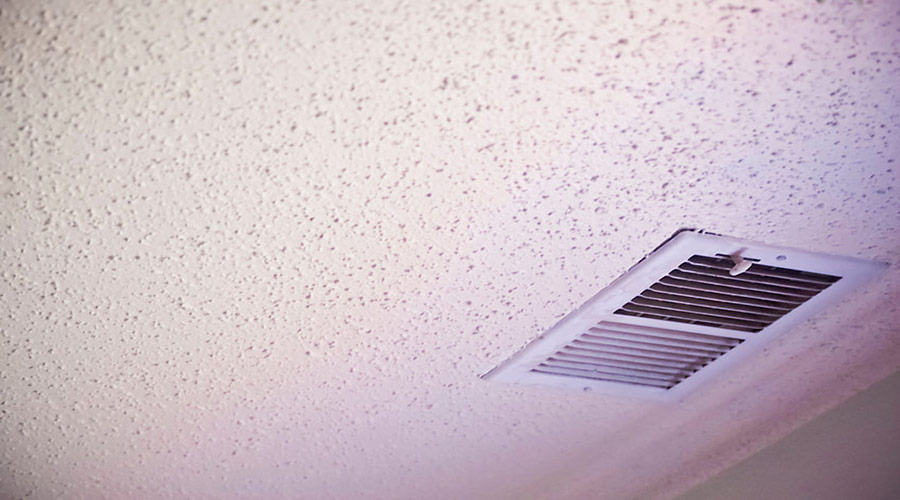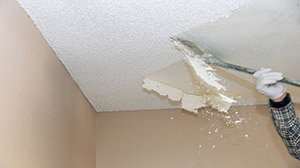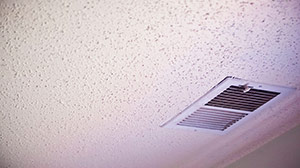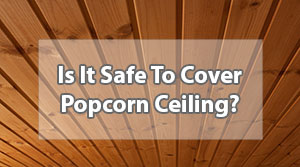
Unfortunately, popcorn ceilings have a poor reputation because of their outdated look. Having one of these ceilings can go as far as impacting the market value of your home.
So, you would think that no one would even think of getting a popcorn ceiling. But does anyone still do popcorn ceilings?
Homeowners still install a popcorn ceiling when they do not want to finish their ceiling yet. Also, it is an option when the ceiling has imperfections that the homeowner is trying to hide. The stippling effect is excellent for hiding the flaws in the ceiling.
Let’s take a look at some of the reasons why anyone still does a popcorn ceiling.
Why Do Some People Still Do Popcorn Ceilings?
It Offers Excellent Camouflage
Creating a popcorn ceiling helps you camouflage these imperfections by mudding and taping the drywall, resulting in an uneven surface.
After constructing the ceiling, the drywall is covered with tape or paper at the seams. The contractor then proceeds to add layers of a joint compound known as mud.
A thin consistency of mud goes on layer after layer to create an even surface that you will finally sand to create a smooth ceiling surface.
The highly textured finish is the perfect cover for any flaws.
The Ceilings Are Cheap To Install
Installing a popcorn ceiling is cheap and also easy, and you can apply the texture yourself. There is not much prepping needed when installing this ceiling. So, a DIY enthusiast can do it.
You can do everything yourself because installing this ceiling doesn’t require specialized equipment.
You begin by cleaning the ceiling surface and smoothing it. Next, you apply the painter’s tape on the seams of the ceiling. It protects the section where the wall and the ceiling meet.
After that, you apply a coat of primer. The primer helps with plaster application which is a base for the popcorn ceiling. Once you have finished prepping the ceiling, you take a drywall texture
sprayer and spray it.
The sprayer has air pressure which allows you to create different, fun effects on the ceiling.
Do Popcorn Ceilings Reduce Noise?
The popcorn ceiling can absorb sounds. That is because the raised bumps increase the surface area, which helps with muffling the sound.
The texture of this ceiling is like cottage cheese. It is bumpy and thick, and that is what provides the noise dampening effect. The uneven surface doesn’t allow the sound to bounce off like a smooth surface. It absorbs the sound like a porous surface.
However, the sound muffling aspect of these ceilings is not perfect. So, don’t expect it to make your home soundproof.
Are There Different Types Of Popcorn Ceilings?
There are two types of popcorn ceilings:
- The light popcorn ceiling
- The popcorn ceiling
The Light Popcorn Ceiling
This ceiling is light on the popcorn effect. It looks more elegant compared to the traditional popcorn ceiling of four decades ago.
The light popcorn ceiling fits well in a room with light-colored paint.
The Popcorn Ceiling
This is the traditional popcorn ceiling. It features the heavy popcorn effect, looks like cottage cheese, and has more acoustic benefits.
Applying this ceiling is time-consuming because it contains Styrofoam and mud. When you touch it, there are more rough patches compared to the light popcorn ceiling.
How Much Does It Cost To Install Popcorn Ceiling?
The average cost of spraying a regular popcorn ceiling is between $700 and $1000. That cost includes the preparation process like sanding, priming, and painting.
However, you should budget for the supplies, labor, and equipment separately. You can expect to spend approximately $300 on this.
Your contractor may advise against installing a plain popcorn ceiling because of its outdated look. Instead, they will offer the option of a different form of textured ceiling.
Ultimately, any texture will camouflage the flaws in your ceiling and offer a better aesthetic than the old popcorn look. Standard popcorn ceilings feature the stipple effect.
The average amount you will use for more updated textures may range between $800 and $1300 for every 500 square feet. The more complex the texture you want to work with, the more expensive it is.
Alternative Types Of Textured Ceilings
A Sheetrock Texture
This texture has been around since 1917, and it is famous. Although it is a rough texture, it doesn’t have the same rough cut as the popcorn.
It features fine lines like a soft crumpled sheet. That is why it earned the name sheetrock.
The sheetrock texture is achieved by using a hand technique rather than using a sprayer. The result is a delicate overall look.
A Swirl Ceiling Texture
The swirl ceiling texture features a basic swirl that you can create using a trowel, sprayer, or roller. It is a time-consuming task that requires a lot of patience and precision.
You create the swirl pattern as you go before the mud dries. That means you have to do the pattern section by section.
Overall, this texture is not as rough as the popcorn. It has smooth and textured sections that mingle with each other.
Crow’s Feet Texture
This texture comes from using a stipple brush. You apply mud at 1/8th of thickness from one corner. Do this to a small section of the ceiling.
Dip your stipple brush in some water and begin to draw out the pattern. This texture is also known as the “Slap-brush” because you slap the wet brush into the 1/8th thick mud on the
ceiling and then pull it away.
The texture appears as short veins running throughout the ceiling. Crow’s feet texture is also known as the stomp texture.
An Orange Peel Texture
This texture is also known as the eggshell texture. It resembles an orange peel. The orange peel texture looks like a lightly lumpy and soft surface compared to the rough and jagged surface of the popcorn ceiling.
You will achieve the orange peel effect by using a spray gun. The gun’s air pressure is set at high, ideally up to 45 psi.
Use the gun to spray a thin layer of mud lightly. It is crucial to have control of the gun. That is because the velocity of the mud, as it moves through the nozzle, is quite high.
To achieve the perfect orange peel texture, keep the gun three to four feet away from the ceiling surface at all times.
Hawk And Trowel Texture
The hawk and trowel texture is easy to achieve because it is not dramatic. It looks like you smoothed over the ceiling surface, but you didn’t achieve perfection.
You will achieve this texture by making random half-swirl patterns on the mud. The trowel is almost flat against the ceiling, but it angles forward a little.
The good news is that this texture does not need you to be highly skilled to achieve it.
Tree Bark Texture
The tree bark texture looks like tree bark. Use a heavy seam roller and mud in a thick consistency. The seam roller will leave a beautiful bark-like texture on the ceiling.
After the first application, you can use a smooth roller to reinforce the pattern without disturbing it.
You can use this texture on both the ceiling and the walls.
Skip Trowel Texture
You achieve this texture by using a trowel or a plastering tool. It requires dragging the trowel dipped in mud across a ceiling.
You have to be gentle as you drag the trowel to achieve the effect that you would like.
The mud will not provide full coverage. Instead, it will leave some areas bare, making random and uneven circles in the ceiling.
The skip trowel texture and the Santa Fe texture are similar. If you cover more than 60% of the ceiling, it is considered a Santa Fe ceiling. If it is less than 60%, it is a skip trowel ceiling.
Knockdown Texture
To achieve the knockdown texture, you have to use a specialized tool called a knockdown. It results in smudges as you “knockdown” the initial droplets from the knockdown tool.
Using the knockdown tool, you can spray the mud at a light, medium and heavy coverage. You let the mud set until the moisture in it evaporates, and it begins to look dull.
If you spray the mud on a painted ceiling, it will take longer for the mud to dry.
The final step is using a putty knife to gently and lightly scrape (knockdown)the semi-dry mud off the ceiling surface. That leaves you with artistic smudges.
If you scrape the mud before it sets properly, you will get a smoother finish. But if you let the mud set for longer and become harder, you will achieve a rougher texture with more bumps.
What Texture Does Popcorn Have?
The popcorn ceiling has a sprayed texture. The spray sand texture is longer lasting than the orange peel texture. It doesn’t separate and cracks over time.
Spray sand texture is excellent for hiding glaring imperfections.
You use sand that is mixed with very thin mud or primer. Take the mixture and spray it onto the ceiling using a hopper gun.
There are other textures that you can choose from away from the popcorn texture. These include:
- The fish scale texture
- The rosebud texture
- The lace ceiling texture
- The textured vinyl wallpaper
- The fashionable ceiling texture
However, these remaining textures require skill and experience creating them. They require specialized equipment, or in some cases, they are very time-consuming and labor-intensive.
Why Are Popcorn Ceilings No Longer Popular?
Aside from its old school, popcorn ceilings are hard to maintain, harder to remove. Besides, people don’t make it anymore.
Here are some reasons why people don’t use popcorn ceilings in their homes.
To Modernize The House
Popcorn ceilings have a reputation for aging your house. So many people stay away from this type of ceiling to keep their houses looking modern.
A modern-looking house has better value on the market compared to the outdated look of the popcorn ceiling.
Remember, popcorn ceilings are associated with homes built in the 70s to the 90s. That was 20 to 40 years ago. Buyers are not interested in a house that looks aged.
They Are Hard to Clean
Popcorn ceilings discolor over time, giving the house a dull look. The ceiling catches dust very quickly.
Unfortunately, no matter how hard you try to clean the ceiling, it never goes back to a pristine state.
You constantly have to take a broom and swat the ceiling to clean it. You don’t have to do that with other modern ceilings.
To Achieve Better Lighting
The bumps in a popcorn ceiling are terrible for lighting. The cause shadows making your house very poorly lit.
It is also not friendly to recessed lights or lights that lie flush against the surface. You have to invest in table lamps or floor lamps to get the right light ambiance in your house.
The Threat Of Asbestos
Modern popcorn ceilings do not pose this threat. However, if your home was built before the mid-80s, there is a likelihood that its popcorn ceiling may have asbestos.
Asbestos was used in popcorn ceilings until 1977, when the United States government banned it. Despite the US Clean Air Act of 1978, the government still allowed these sprayed-on asbestos popcorn ceilings until the existing stock ran out. The last of the ceilings were used in the mid-80s.
Asbestos was useful in hiding flaws in the ceiling.
If you have an old home from this era, you are at risk of inhaling asbestos from the ceiling. That makes the popcorn ceiling an active health hazard.
They Are Hard To Maintain
It isn’t easy to repair a popcorn ceiling. If there is a problem like a dent in the ceiling, you may have to consider removing the whole thing.
Repairs ruin the continuity of the popcorn effect. The site of the repair will not look seamless.
Also, when a popcorn ceiling begins to disintegrate, it causes a heavy mess on the furniture. It crumbles and deteriorates fast.
Removal Is A Nightmare
It is time-consuming and messy. You have to protect the floor and walls to ensure that the ceiling doesn’t smear on everything. Also, you need a team of people to move the process along on time.
And the process of removing the ceiling can damage the ceiling surface since you have to scrape it off.
So, Do People Still Install Popcorn Ceilings?
A few people may still cling to popcorn ceilings, but they are not the ideal ceiling option for modern living.
These ceilings may be cheap and easy to install, but they are a nightmare to maintain and remove. In addition, they make your house lose its aesthetic appeal and market value.
And when it comes to longevity, they have an average service life.
There are plenty of better options on the market that far outperform and look better than a popcorn ceiling.




